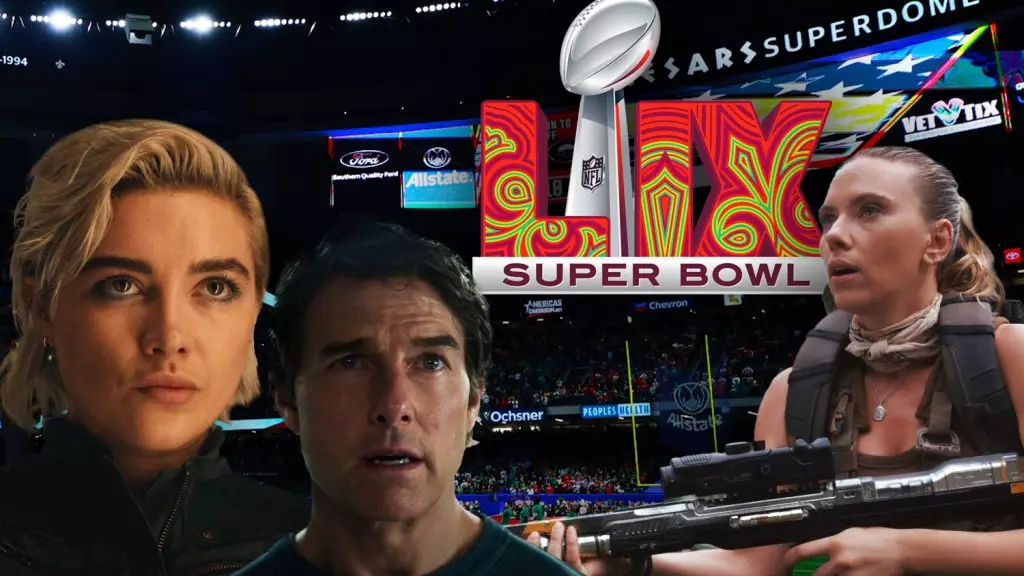The Super Bowl is not just a significant sporting event; it is also a powerful platform for advertisers. Each year, the game draws millions of viewers, making it a prime opportunity for film studios to showcase their upcoming releases. In 2023, the event reached a staggering 123.7 million viewers through live television and streaming services, demonstrating the continued relevance of live sports in today’s media landscape. However, the high cost of advertising during the Super Bowl, which can range from $7.5 million to $8 million for a 30-second spot, means only a select few studios can afford to participate. This article explores the strategies employed by major studios and assesses their potential impact on upcoming movie releases.
In recent years, three movie studios have established themselves as frequent participants in the Super Bowl advertising arena: Disney, Universal, and Paramount. Disney led the charge with over $2.2 billion in domestic box office receipts in 2023. They have a history of unveiling major projects during the Super Bowl, making it likely that they will utilize this platform to promote their upcoming films, including highly anticipated releases like *Snow White* and *Lilo & Stitch*. Furthermore, their slate of Marvel movies promises to draw significant audience attention, continuing the trend of capitalizing on their established franchises.
In contrast, Universal Pictures, which grossed approximately $1.88 billion domestically in 2024, is expected to showcase its creative adaptations, such as the live-action *How to Train Your Dragon* and *Jurassic World Rebirth*. Universal has established a reputation for intrigue and innovative marketing strategies, notably using stunts like public displays featuring characters from its films. Such tactics not only capture viewer interest during the Super Bowl but also create a cultural buzz that can amplify a film’s reach beyond the game.
Paramount, while often overshadowed by its competitors, has successfully navigated Super Bowl promotions in previous years. This year, the studio is expected to launch trailers for films such as *Novacaine* and a new *Mission: Impossible* installment. The studio’s consistent presence at the Super Bowl highlights its commitment to maintaining visibility and relevance in a competitive landscape, even when its sister network is not broadcasting the event.
Interestingly, a number of major studios have chosen to forgo advertising opportunities during the Super Bowl this year. Companies like Sony, Warner Bros, Netflix, Amazon, MGM Studios, and Lionsgate have opted out of this year’s event. The strategic reasons behind this absence may be multifaceted; financial constraints, shifts in marketing approaches, or a reevaluation of the efficacy of traditional advertising methods could all be at play.
For example, Warner Bros had a notable presence with *The Flash* in 2023 but seems to be sitting back this year, opting instead for more cost-effective marketing channels. The rise of digital advertising and the increasing effectiveness of targeted social media promotions may have influenced this decision, as studios reassess where and how they invest their marketing budgets.
The evolution of Super Bowl advertising reflects broader changes in the entertainment industry as studios adapt to new challenges. While the Super Bowl remains an influential platform for reaching audiences, a trend is emerging where studios are leveraging digital avenues and data-driven campaigns to target audiences more effectively.
Simultaneously, the continued interest in live sports is apparent; as long as these events maintain viewership numbers in the millions, studios are likely to capitalize on them. Future Super Bowls will likely see both familiar faces and newcomers in the advertising landscape — a testament to the ever-changing dynamics of film marketing.
The Super Bowl serves as a battleground for filmmakers and studios, providing them with an opportunity to reach one of the largest live audiences imaginable. The participation of the top studios, along with the absence of others, indicates a broader trend in how films are marketed in today’s evolving landscape. The event will undoubtedly remain a key visit for audience engagement and revenue generation, as brands continue to explore innovative ways to leverage its potential.

